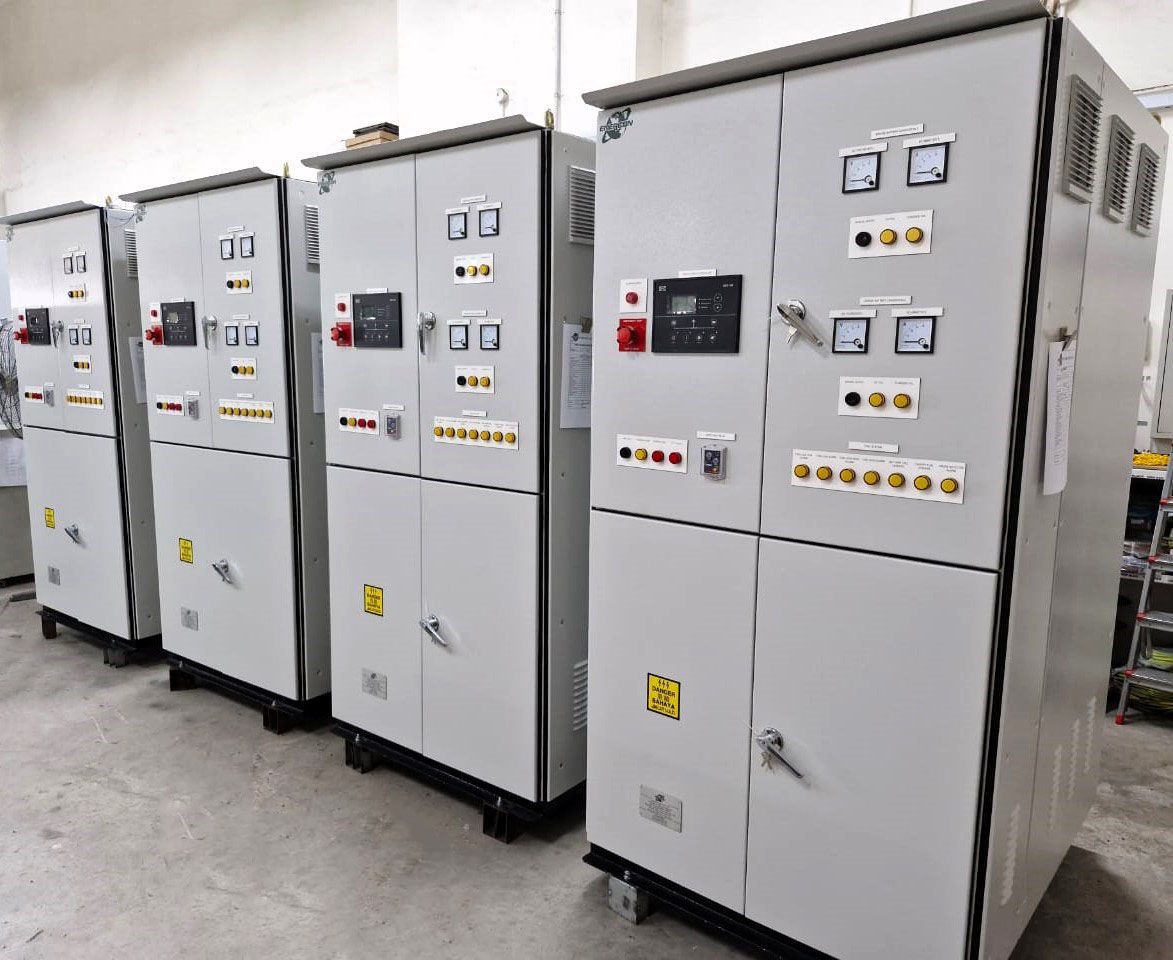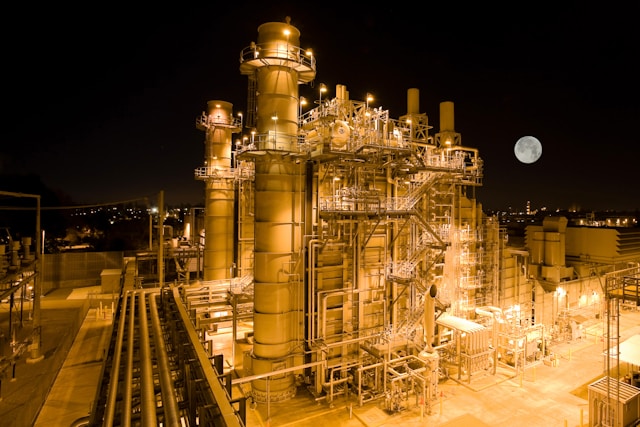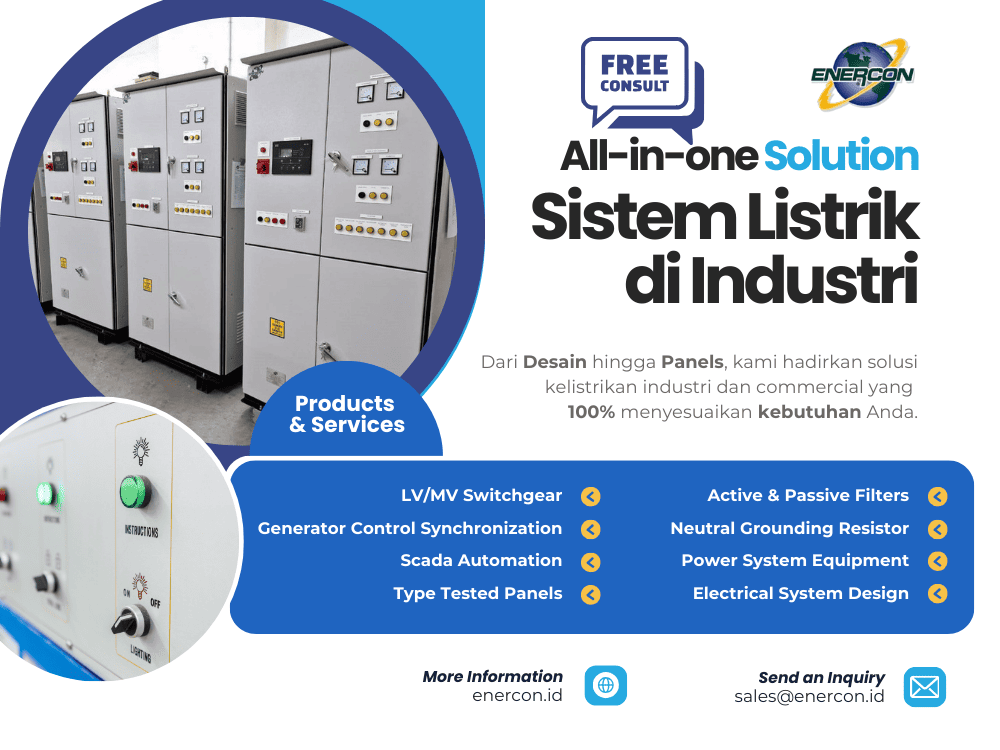When it comes to reliable power distribution, low-voltage (LV) switchgear is the nerve center of your facility. Whether you run a manufacturing plant, data center, or oil & gas site, the switchgear determines how electricity flows, how faults are contained, and how safely your team can operate. In short: it’s not just metal and breakers—it’s the foundation of uptime, safety, and efficiency.
At Enercon Indonesia, we view LV switchgear as part of a larger ecosystem: motor control centers (MCCs), generator synchronization panels, power-quality solutions, and SCADA dashboards. When these pieces work together, you get more than distribution—you get resilience and insight.
This guide breaks down what LV switchgear does, where it fits, what to look for when specifying, and how to integrate it for long-term performance. If you’re planning an upgrade or new build, this is the playbook to start with.
What Low Voltage Switchgear Does – And Why It Matters
Power distribution
Low voltage switchgear ensures electricity flows safely from the transformer or generator bus to different feeders, motors, and sub-panels across your facility. Without it, power distribution would be inconsistent and difficult to control.
Protection
It serves as the first line of defense when something goes wrong. Overloads, short circuits, or ground faults are quickly isolated, protecting both equipment and people. A well-specified switchgear keeps small issues from turning into plant-wide outages.
Safety
By providing safe isolation, technicians can perform maintenance or testing without shutting down the entire system. This reduces downtime while keeping safety protocols intact.
Integration with modern systems
In today’s facilities, switchgear rarely works alone. It connects with motor control centers (MCCs), power quality devices, genset synchronization panels, and SCADA or cloud dashboards. This integration transforms it from a passive device into an active part of your energy strategy.
Read: MV Switchgear: Key Functions, Benefits, and Applications
Placement in Electrical Architecture
Main LV switchboard
This is the central hub of your facility’s electrical system. It sits downstream of the transformer or generator bus and distributes power to the rest of the plant.
Sub-switchboards and MCCs
These boards are placed closer to process areas and motor-heavy sections. They manage distribution at a more localized level and often integrate motor starters, soft starters, or variable frequency drives.
Generator and grid interface
When your facility uses backup generation, the LV switchgear connects with automatic transfer switches (ATS), synchronization controls, and load-sharing logic. This ensures smooth transitions between power sources with minimal disruption.
Data and monitoring layer
Modern LV switchgear is not just hardware. By connecting to SCADA systems or cloud-based dashboards, it provides real-time insights, alarms, and energy performance indicators. This visibility allows faster response to problems and better planning for efficiency.
Key Specifications to Get Right
Ratings and fault levels
Always begin with the basics: system voltage, busbar current rating, and short-circuit withstand capacity (Icw/Ipk). In Indonesia, don’t forget to consider ambient temperature and altitude adjustments, as both can affect performance and reliability.
Form of separation
From Form 2 up to Form 4b, the choice determines how well functional units are isolated from each other. Higher forms improve safety and uptime but come with added cost and space requirements.
Environmental protection
Switchgear must survive in the real world, not just in a datasheet. Specify ingress protection (IP), anti-corrosion or tropicalization treatments, and proper ventilation for hot and humid conditions.
Safety features
Shutters, interlocks, and arc-flash reduction designs should be part of the requirement. In higher-risk areas, remote racking or remote operation is worth considering to keep personnel safe.
Integration readiness
Make space for current transformers (CTs), voltage transformers (VTs), power quality meters, and gateways that can speak Modbus/TCP or IEC 61850. Without this, you’ll struggle to connect to SCADA or cloud dashboards later.
Read: Commercial Renewable Energy: A Complete Guide for Businesses
Protection and Selectivity That Actually Works
Time–current coordination
Good switchgear design ensures breakers trip in sequence. A fault on one feeder should not bring down the entire board. Coordinated settings confine problems to the smallest possible section, keeping most of the plant running.
Ground-fault protection
Ground faults are among the most common and damaging electrical issues. Properly tuned relays catch these events quickly without nuisance tripping. The goal is to protect both conductors and equipment without unnecessary downtime.
Zone-selective interlocking
For critical facilities like data centers or continuous production lines, zone-selective interlocking or differential protection gives an extra layer of speed and selectivity. It allows breakers to clear faults faster while limiting the impact zone.
Documentation and visibility
A protection study and coordination curves should always be part of your specification. During commissioning, make sure the final “as-set” protection settings are documented. Once live, publish breaker states, trip causes, and alarms to SCADA or dashboards so problems can be diagnosed in minutes, not hours.
Designing for Power Quality and Efficiency
Power factor management
Many facilities in Indonesia face utility penalties when power factor drops below a threshold. By embedding capacitor banks or static var generators (SVG) inside or near the switchgear, you can correct power factor and stabilize voltage without costly retrofits later.
Harmonic mitigation
Variable frequency drives (VFDs) and other nonlinear loads create harmonics that overheat transformers, damage sensitive equipment, and trigger nuisance trips. Planning space for active or passive filters within the switchgear layout helps keep total harmonic distortion (THD) under control.
Drive and motor readiness
Modern production lines are increasingly VFD-heavy. When specifying switchgear, consider the thermal load, ventilation, and feeder design so future drive installations don’t require costly rebuilds. Spare bays and proper bus ratings save both time and money.
Measurement and visibility
A good metering package is more than just a kWh counter. Specify meters that log demand, harmonics, and power factor, then feed that data into SCADA or cloud dashboards. This transforms your switchgear into a live energy management tool, not just a breaker box.
Read: Neutral Grounding Resistor (NGR): Function, Sizing, and Safety Basics
The Rise of Digital Switchgear
SCADA integration
Modern switchgear is expected to do more than carry current. By integrating with SCADA, it can stream live values, trigger alarms, and support operator workflows. This gives maintenance teams instant visibility when issues arise.
Cloud dashboards
For organizations with multiple plants or facilities, cloud dashboards take monitoring a step further. They aggregate energy KPIs across sites, making it easier for managers to compare performance, spot trends, and plan improvements without being on-site.
Cybersecurity as a design factor
With connectivity comes risk. Switchgear that is SCADA- or cloud-ready should also include cyber hygiene from the start: VLAN segregation, user roles, and regular firmware updates. Building these safeguards into your specification prevents headaches later.
The Rise of Digital Switchgear
SCADA integration
Modern switchgear is expected to do more than carry current. By integrating with SCADA, it can stream live values, trigger alarms, and support operator workflows. This gives maintenance teams instant visibility when issues arise.
Cloud dashboards
For organizations with multiple plants or facilities, cloud dashboards take monitoring a step further. They aggregate energy KPIs across sites, making it easier for managers to compare performance, spot trends, and plan improvements without being on-site.
Cybersecurity as a design factor
With connectivity comes risk. Switchgear that is SCADA- or cloud-ready should also include cyber hygiene from the start: VLAN segregation, user roles, and regular firmware updates. Building these safeguards into your specification prevents headaches later.
FAT, SAT, and Commissioning Essentials
Factory Acceptance Test (FAT)
Before switchgear leaves the factory, FAT confirms the build quality and functionality. This includes visual inspections, mechanical checks, electrical routine tests, interlock verification, and functional I/O testing. Catching issues at this stage saves costly site delays.
Site Acceptance Test (SAT)
Once installed, SAT validates the equipment on-site. It covers installation quality, wiring checks, protection relay settings, and integration with SCADA or monitoring systems. SAT ensures the board works exactly as designed in the real operating environment.
Commissioning pack
A complete handover should include as-built drawings, “as-set” protection settings, I/O mapping, communications register lists, spares, and O&M documentation. This package becomes the reference for future maintenance and troubleshooting.
First-year maintenance
The first 12 months are critical. Schedule thermal imaging scans, torque checks, cleaning, breaker/relay tests, and firmware updates. Preventive maintenance in year one sets the tone for reliable operation in the years to come.
Read: Optimizing Energy in Commercial and Industrial Sectors: Proven Strategies
Typical Configurations by Industry
Data centers
Data centers demand uninterrupted uptime. Typical LV switchgear layouts here are dual-ended with a bus-tie, UPS input and output sections, and integrated generator interfaces. Features like zone-selective interlocking and arc-flash mitigation are common. SCADA, BMS, and EMS integration is a must to ensure operators have complete visibility across all power systems.
Manufacturing and process industries
In food, beverage, and general manufacturing, boards are usually paired with motor control centers (MCCs). They need to support heavy use of variable frequency drives, capacitor banks, or SVGs for power factor correction, and harmonic filters to protect sensitive equipment. Cloud dashboards that provide shift-level KPIs are increasingly popular, helping production and maintenance teams work from the same data.
Oil and gas (onshore and offshore)
Oil and gas facilities require ruggedized switchgear built for extreme environments. This often means corrosion protection, seismic tolerance, and explosion-proof designs where hazardous zones exist. These switchboards integrate tightly with SCADA systems, industrial battery chargers, and DC power systems. Access clearances and maintainability are critical, since service often has to be performed in harsh conditions.
Writing a Clean RFP
Define system parameters
Start with the essentials: voltage level, busbar ratings, and fault withstand capacity. Include derating requirements for temperature and altitude so vendors can design accordingly.
Specify assembly requirements
Clarify the form of separation (e.g., Form 4b), ingress protection, and corrosion or tropicalization needs. If seismic or vibration tolerance matters, make that explicit too.
Detail breaker and relay expectations
List acceptable breaker models and relay types. Indicate whether you require features like zone-selective interlocking or differential protection schemes, and define your ground-fault strategy upfront.
Include power quality and metering scope
Ask for integrated power factor correction, capacitor banks or SVGs, and harmonic filters where relevant. Require meters that log demand, power factor, and harmonics, not just energy consumption.
Set integration expectations
Define the communication protocols (Modbus/TCP, IEC 61850 if applicable), provide a points list for SCADA, and state cybersecurity requirements such as role-based access and network segregation.
Clarify testing and documentation
Spell out FAT and SAT scope, commissioning deliverables, and the documentation set you expect. This should include as-built drawings, protection settings, spares, O&M manuals, and training for your staff.
Why Enercon Indonesia?
Custom-engineered solutions
No two facilities are the same. Enercon Indonesia designs low voltage switchgear to match your standards, loads, and environmental conditions, ensuring that the system works seamlessly within your site’s unique requirements.
True turnkey delivery
Instead of coordinating multiple vendors, Enercon offers a single accountable team. From switchgear and MCCs to SCADA integration, power quality devices, industrial chargers, and even automated fuel systems, everything is delivered and commissioned under one roof. This approach shortens project timelines and reduces risk.
Proven reliability
Enercon’s track record includes multi-generator synchronization projects, VFD-heavy manufacturing lines, and mission-critical facilities such as data centers. These projects demonstrate the company’s ability to deliver safe, resilient, and high-performance switchgear systems.
Next Steps
If you are planning a new facility or upgrading existing electrical systems, the first step is to get the specification right. A well-designed low voltage switchgear is more than just breakers and busbars—it is the foundation of uptime, safety, and efficiency for the entire plant.
What you can do today
- Request an engineering consultation to review your single-line diagram and identify gaps in protection or power quality.
- Ask for Enercon’s editable spec bundle, including an SLD template, coordination study scope, and SCADA I/O list, to guide vendor discussions.
- Schedule a site walk-through to measure harmonics, assess expansion needs, and prepare for future integration with drives or renewable energy sources.
Enercon Indonesia has the expertise to deliver switchgear that works from day one and scales with your facility’s needs. The result is a system that keeps your operations safe, efficient, and ready for tomorrow.





